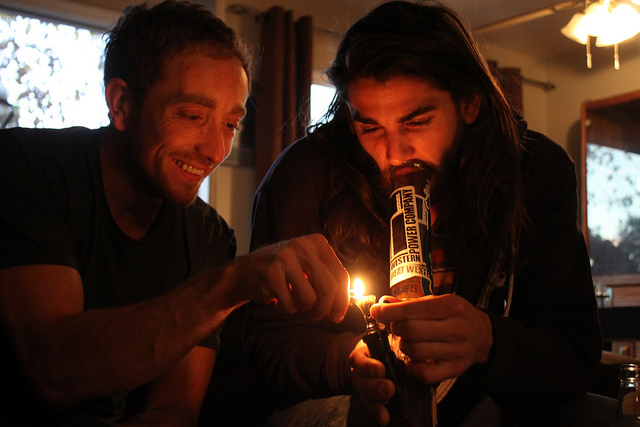Prop. 64 made cannabis legal in California, but what does that mean?
Two friends enjoy cannabis using a water pipe, while assisting one another in their shared elation.
December 7, 2016
Proposition 64 has passed in the state of California. For those of you that don’t know what Prop. 64 is, it’s the cannabis initiative which has just made recreational marijuana legal.
For those strongly opposed to pot smoking, this might make you infuriated. For those who love smoking that sweet ganja, you might be taking a celebratory bong rip to the dome at this moment.
But don’t be too mad that this initiative passed, and also don’t celebrate too hard. Prop. 64 doesn’t mean the streets of California are going to be filled with cannabis smoke, because it’s actually still illegal to be smoking on public property, and frankly, prop. 64 makes smoking cannabis outside just like drinking alcohol outside — cannabis will be just like an open alcohol container.
If one is caught smoking a joint, they could be subject to a ticket, and also if they are acting disorderly, be detained for public intoxication. Also prior to Prop. 64 passing, there was no standardized limit for driving under the influence while high on cannabis — now there is, sort of.
The limit hasn’t been set at any particular number in the state of California, but according to Barbara Hewitt, Diablo Valley College’s addiction studies coordinator, California will probably be moving towards what other states have set as their legal driving limit as “a blood level of five nanograms of THC,” with anything over that level being considered intoxicated.
Unfortunately — for people who ingest cannabis — that legal level, set by other states right now, is actually extremely low, especially for a substance which has been tested as inconclusive with how it actually impairs a person’s driving ability. Comparatively, alcohol, which objectively impairs your driving ability, has a much higher legal driving limit.
However, until that number is actually set in stone, police will have to rely on sobriety tests. Suspected intoxicated drivers will be challenged with tests, according to Hewitt, such as having a suspect “close their eyes for 30 seconds” and seeing how near they come to that number. If a suspect opens their eyes far too early, they could be drunk, if they open them far too late, the suspect could be high.
Those are just some of the things you can expect to happen immediately.
As of Nov. 9th, pot is legal to smoke for anyone over the age of 21 and in a private setting. But cities still haven’t figured out how they are going to run their own legislation. Outdoor cultivation, sale of recreational cannabis, and licensing marijuana retailers are all things that are going to have to be figured out city to city. Most likely, cities around the state are probably like the city of Pleasant Hill, who won’t be meeting until January to figure out what this new law means. This is quite common for most California cities right now; most don’t know what they are going to do.
Regardless of what some cities decide to do, some are going to become cannabis capitals, and others are going to become dry districts where pot will remain stigmatized. This could disrupt many of California’s borders and areas of population density. If cultivation is important to people, and other people see a profit to be made off the cannabis industry, then we could see a mass migration to the highly acclaimed cannabis country of California known as the “Emerald Triangle,” or better known to non-pot smokers as the counties of Humboldt, Trinity, and Mendocino.
The Emerald Triangle is already an area of mass cultivation, and there’s little reason for anyone to believe that that’s going to change anytime soon, especially with prohibition being lifted. Humboldt, Trinity, and Mendocino could be seeing a major influx of people migrating in the hopes to cash in on some green gold. On the other hand, those areas have always been open to mass cultivation, even though weed was still illegal in those areas. So perhaps there won’t be a major migration to these parts, but instead perhaps that migration has already taken place. It’s hard to say.
When Colorado opened its doors to cannabis on Jan. of 2014, they did something very similar to California with regards to the recreational sale of marijuana: they didn’t allow for the sale of recreational pot until two years after amendment 64 (Colorado’s proposition name) was passed. This was to ensure that the industry didn’t just explode with random cannabis stores which didn’t have a standard for what they were selling. California has done exactly the same thing.
Under Prop. 64, pot will fall under the watchful eyes of the Department of Food and Agriculture and the Department of Public Health. Frankly, the cannabis industry having extra departments making sure the product is safe should hypothetically turn out to be a good thing. For now, that remains to be seen. What could end up happening though might be the departments will end up pushing out the mom and pop growing operations, and end up favoring big money cannabis. Some of the requirements that the departments might set could be too difficult for a small grower to comply with. However, just like everything else that the proposition promises, this still remains to be seen.
The other thing these departments could shake up is the edible industry, according to Ben Adlin in Leafly.com, “Prop. 64 prohibits products ‘easily confused with commercially sold candy or foods that do not contain marijuana.'” This could be any edible, because a pot brownie could easily be confused with a regular brownie — they look identical. Perhaps edible makers will have to start making their products in pot leaf shapes just to get rid of the confusion, or maybe this could simply just be solved with a simple label on products containing cannabis’ psychoactive compound THC.
Regardless, Prop. 64 still has a lot of legislation that still needs to be worked out. Good thing California has allowed for some extra years to get everything into working order.







































































